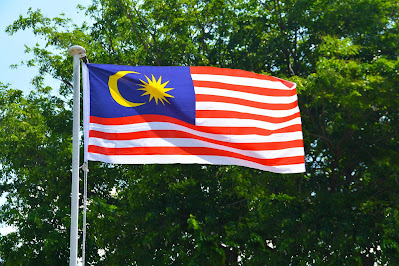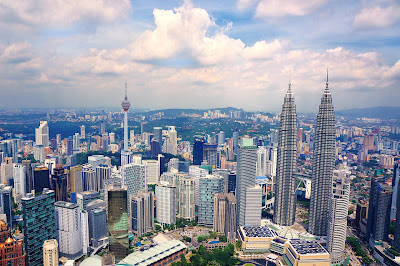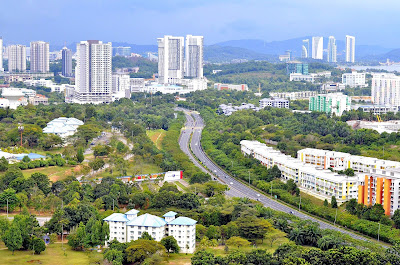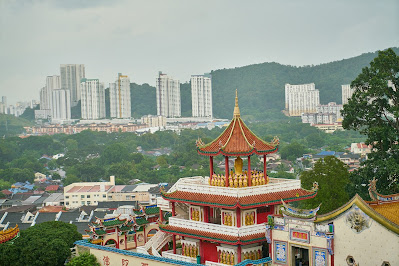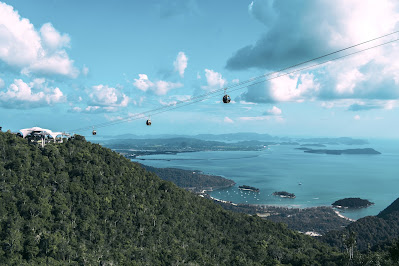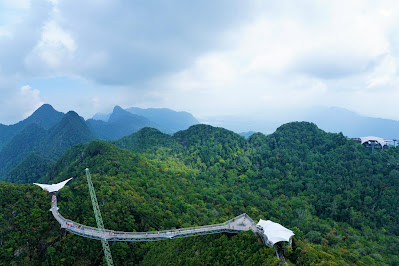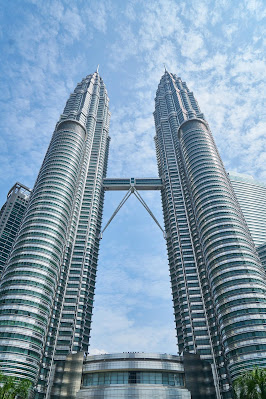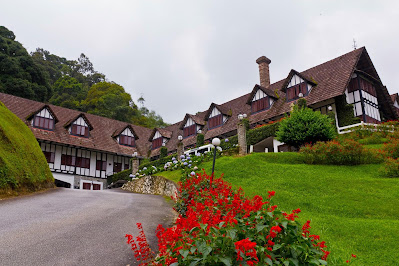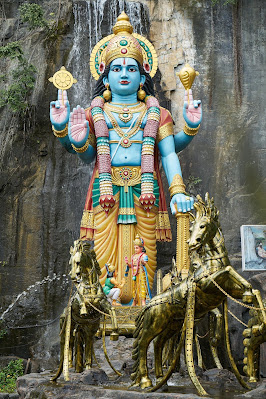Malaysia , All About Malaysia, Malaysia Tourism, Malaysian Life, Facts about Malaysia
Malaysia is a country in Southeast Asia. The federal constitutional monarchy consists of thirteen states and three federal territories, separated by the South China Sea into two regions, Peninsular Malaysia and Borneo's East Malaysia. Peninsular Malaysia shares a land and maritime border with Thailand and maritime borders with Singapore, Vietnam, and Indonesia. East Malaysia shares land and maritime borders with Brunei and Indonesia and a maritime border with the Philippines and Vietnam. Kuala Lumpur is the national capital, largest city and the seat of the legislative branch of the federal government. The nearby planned capital of Putrajaya is the administrative capital, which represents the seat of both the executive branch (Cabinet, federal ministries and agencies) and the judicial branch of the federal government. With a population of over 32 million, Malaysia is the world's 44th-most populous country. The southernmost point of continental Eurasia is in Tanjung Piai. In the tropics, Malaysia is one of 17 megadiverse countries, home to numerous endemic species.
Malaysia has its origins in the Malay kingdoms which, from the 18th century, became subject to the British Empire, along with the British Straits Settlements protectorate. Peninsular Malaysia was unified as the Malayan Union in 1946. Malaya was restructured as the Federation of Malaya in 1948 and achieved independence on 31 August 1957. The independent Malaya united with the then British crown colonies of North Borneo, Sarawak, and Singapore on 16 September 1963 to become Malaysia. In August 1965, Singapore was expelled from the federation and became a separate independent country.
The country is multiethnic and multicultural, which has a significant effect on its politics. About half the population is ethnically Malay, with minorities of Chinese, Indians, and indigenous peoples. The country's official language is Malaysian, a standard form of the Malay language. English remains an active second language. While recognising Islam as the country's established religion, the constitution grants freedom of religion to non-Muslims. The government is modelled on the Westminster parliamentary system and the legal system is based on common law. The head of state is an elected monarch, chosen from among the nine state sultans every five years. The head of government is the Prime Minister.
After independence, the Malaysian GDP grew at an average of 6.5% per annum for almost 50 years. The economy has traditionally been fuelled by its natural resources but is expanding in the sectors of science, tourism, commerce and medical tourism. Malaysia has a newly industrialised market economy, ranked third-largest in Southeast Asia and 33rd-largest in the world. It is a founding member of ASEAN, EAS, OIC and a member of APEC, the Commonwealth and the Non-Aligned Movement.
History
Evidence of modern human habitation in Malaysia dates back 40,000 years. In the Malay Peninsula, the first inhabitants are thought to be Negritos. The Austronesian expansion which originated from Taiwan went to the Philippines and then Borneo, eventually arrived in Malaysia. Malay the national language is classified as a Greater North Bornean language and came to the Malay Peninsula via immigration from Borneo and Sumatra. Traders and settlers from India and China arrived as early as the first century AD, establishing trading ports and coastal towns in the second and third centuries. Their presence resulted in strong Indian and Chinese influences on the local cultures, and the people of the Malay Peninsula adopted the religions of Hinduism and Buddhism. Sanskrit inscriptions appear as early as the fourth or fifth century. The Kingdom of Langkasuka arose around the second century in the northern area of the Malay Peninsula, lasting until about the 15th century. Between the 7th and 13th centuries, much of the southern Malay Peninsula was part of the maritime Srivijayan empire. By the 13th and the 14th century, the Majapahit empire had successfully wrested control over most of the peninsula and the Malay Archipelago from Srivijaya. Islam began to spread among Malays in the 14th century. In the early 15th century, Parameswara, a runaway king of the former Kingdom of Singapura linked to the old Srivijayan court, founded the Malacca Sultanate. Malacca was an important commercial centre during this time, attracting trade from around the region. Malacca was also the dynastic head of a network of Malay Sultanates stretching from the west, at Aceh in Indonesia, to the east, in Maguindanao at the Philippines.
In 1511, Malacca was conquered by Portugal, after which it was taken by the Dutch in 1641. In 1786, the British Empire established a presence in Malaya, when the Sultan of Kedah leased Penang Island to the British East India Company. The British obtained the town of Singapore in 1819, and in 1824 took control of Malacca following the Anglo-Dutch Treaty. By 1826, the British directly controlled Penang, Malacca, Singapore, and the island of Labuan, which they established as the crown colony of the Straits Settlements. By the 20th century, the states of Pahang, Selangor, Perak, and Negeri Sembilan, known together as the Federated Malay States, had British residents appointed to advise the Malay rulers, to whom the rulers were bound to defer by treaty. The remaining five states in the peninsula, known as the Unfederated Malay States, while not directly under British rule, also accepted British advisers around the turn of the 20th century. Development on the peninsula and Borneo were generally separate until the 19th century. Under British rule the immigration of Chinese and Indians to serve as labourers was encouraged. The area that is now Sabah came under British control as North Borneo when both the Sultan of Brunei and the Sultan of Sulu transferred their respective territorial rights of ownership, between 1877 and 1878. In 1842, Sarawak was ceded by the Sultan of Brunei to James Brooke, whose successors ruled as the White Rajahs over an independent kingdom until 1946, when it became a crown colony.
In the Second World War, the Japanese Army invaded and occupied Malaya, North Borneo, Sarawak, and Singapore for over three years. During this time, ethnic tensions were raised and nationalism grew. Popular support for independence increased after Malaya was reconquered by Allied forces. Post-war British plans to unite the administration of Malaya under a single crown colony called the "Malayan Union" met with strong opposition from the Malays, who opposed the weakening of the Malay rulers and the granting of citizenship to the ethnic Chinese. The Malayan Union, established in 1946, and consisting of all the British possessions in the Malay Peninsula with the exception of Singapore, was quickly dissolved and replaced on 1 February 1948 by the Federation of Malaya, which restored the autonomy of the rulers of the Malay states under British protection.
Federation brought heightened tensions including a conflict with Indonesia as well continuous conflicts against the Communists in Borneo and the Malayan Peninsula which escalates to the Sarawak Communist Insurgency and Second Malayan Emergency together with several other issues such as the cross border attacks into North Borneo by Moro pirates from the southern islands of the Philippines, Singapore being expelled from the Federation in 1965, and racial strife. This strife culminated in the 13 May race riots in 1969. After the riots, the controversial New Economic Policy was launched by Prime Minister Tun Abdul Razak, trying to increase the share of the economy held by the bumiputera. Under Prime Minister Mahathir Mohamad there was a period of rapid economic growth and urbanisation beginning in the 1980s. The economy shifted from being agriculturally based to one based on manufacturing and industry. Numerous mega-projects were completed, such as the Petronas Towers, the North–South Expressway, the Multimedia Super Corridor, and the new federal administrative capital of Putrajaya. However, in the late 1990s the Asian financial crisis almost caused the collapse of the currency and the stock and property markets, although they later recovered. The 1MDB scandal was a major global corruption scandal that implicated then-Prime Minister Najib Razak in 2015. The scandal contributed to the first change in ruling political party since independence in the 2018 general election. In the 2020s, the country was gripped by political crisis that coincided with health and economic crises caused by the COVID-19 pandemic.
Government and politics
Malaysia is a federal constitutional elective monarchy; the only federal country in Southeast Asia. The system of government is closely modelled on the Westminster parliamentary system, a legacy of British rule. The head of state is the King, whose official title is the Yang di-Pertuan Agong. The King is elected to a five-year term by and from among the nine hereditary rulers of the Malay states. The other four states, which have titular Governors, do not participate in the selection. By informal agreement the position is rotated among the nine, and has been held by Abdullah of Pahang since 31 January 2019. The King's role has been largely ceremonial since changes to the constitution in 1994, picking ministers and members of the upper house.
Legislative power is divided between federal and state legislatures. The bicameral federal parliament consists of the lower house, the House of Representatives and the upper house, the Senate. The 222-member House of Representatives is elected for a maximum term of five years from single-member constituencies. All 70 senators sit for three-year terms; 26 are elected by the 13 state assemblies, and the remaining 44 are appointed by the King upon the Prime Minister's recommendation. The parliament follows a multi-party system and the government is elected through a first-past-the-post system. Parliamentary elections are held at least once every five years, the most recent of which took place in May 2018. Before 2018, registered voters aged 21 and above could vote for the members of the House of Representatives and, in most of the states, for the state legislative chamber. Voting is not mandatory. In July 2019, a bill to lower the voting age to 18 years old was officially passed. Malaysia's ranking increased by 9 places in the 2019 Democracy Index to 43th compared to the previous year, and is classified as a 'flawed democracy'.
Executive power is vested in the Cabinet, led by the Prime Minister. The prime minister must be a member of the House of Representatives, who in the opinion of His Majesty the King, commands the support of a majority of members. The Cabinet is chosen from members of both houses of Parliament. The Prime Minister is both the head of cabinet and the head of government. As a result of the 2018 general election Malaysia was governed by the Pakatan Harapan political alliance, although Prime Minister Mahathir Mohamad resigned amid a political crisis in 2020. In March 2020, the Perikatan Nasional coalition formed under Prime Minister Muhyiddin Yassin, before Muhyiddin lost majority support and was replaced by deputy Prime Minister Ismail Sabri Yaakob, a veteran politician from UMNO, in August 2021.
Malaysia's legal system is based on English Common Law. Although the judiciary is theoretically independent, its independence has been called into question and the appointment of judges lacks accountability and transparency. The highest court in the judicial system is the Federal Court, followed by the Court of Appeal and two high courts, one for Peninsular Malaysia and one for East Malaysia. Malaysia also has a special court to hear cases brought by or against royalty. The death penalty is in use for serious crimes such as murder, terrorism, drug trafficking, and kidnapping. Separate from and running parallel to the civil courts are the Syariah Courts, which apply Shariah law to Muslims in the areas of family law and religious observances. Homosexuality is illegal in Malaysia, and the authorities can impose punishment such as caning. Human trafficking and sex trafficking in Malaysia are significant problems.
Race is a significant force in politics. Affirmative actions such as the New Economic Policy and the National Development Policy which superseded it, were implemented to advance the standing of the bumiputera, consisting of Malays and the indigenous tribes who are considered the original inhabitants of Malaysia, over non-bumiputera such as Malaysian Chinese and Malaysian Indians. These policies provide preferential treatment to bumiputera in employment, education, scholarships, business, and access to cheaper housing and assisted savings. However, it has generated greater interethnic resentment.There is ongoing debate over whether the laws and society of Malaysia should reflect secular or Islamic principles. Islamic criminal laws passed by the Pan-Malaysian Islamic Party with the support of United Malays National Organisation (UMNO) state assemblymen in the state legislative assembly of Kelantan have been blocked by the federal government on the basis that criminal laws are the responsibility of the federal government.
Malaysia's ranking in the 2020 Press Freedom Index increased by 22 places to 101st compared to the previous year, making it one of two countries in Southeast Asia without a 'Difficult situation' or 'Very Serious situation' with regards to press freedom. However, it fell 18 places the following year due to the policies of the Perikatan Nasional government. Malaysia is marked in the 50–59 range according to the 2019 Corruption Perceptions Index, indicating a moderate level of corruption. Freedom House noted Malaysia as "partly free" in its 2018 survey. A lawsuit filed by Department of Justice (DOJ), alleged that at least $3.5 billion has been stolen from Malaysia's 1MDB state-owned fund. On 28 July 2020, former Prime Minister Najib Razak was found guilty on seven charges in the 1Malaysia Development Berhad scandal. He was sentenced to 12 years in prison.
States
A list of thirteen states and each state capital (in brackets):
Johor (Johor Bahru)
Kedah (Alor Setar)
Kelantan (Kota Bharu)
Malacca (Malacca City)
Negeri Sembilan (Seremban)
Pahang (Kuantan)
Penang (George Town)
Perak (Ipoh)
Perlis (Kangar)
Selangor (Shah Alam)
Sabah (Kota Kinabalu)
Sarawak (Kuching)
Terengganu (Kuala Terengganu)
Federal Territories
Kuala Lumpur - Federal Territory of Kuala Lumpur
Labuan - Federal Territory of Labuan
Putrajaya - Federal Territory of Putrajaya
Geography
Malaysia is the 66th largest country by total land area, with a land area of 329,613 km2 (127,264 sq mi). It has land borders with Thailand in West Malaysia, and Indonesia and Brunei in East Malaysia. It is linked to Singapore by a narrow causeway and a bridge. The country also has maritime boundaries with Vietnam and the Philippines. The land borders are defined in large part by geological features such as the Perlis River, the Golok River and the Pagalayan Canal, whilst some of the maritime boundaries are the subject of ongoing contention. Brunei forms what is almost an enclave in Malaysia, with the state of Sarawak dividing it into two parts. Malaysia is the only country with territory on both the Asian mainland and the Malay archipelago. Tanjung Piai, located in the southern state of Johor, is the southernmost tip of continental Asia. The Strait of Malacca, lying between Sumatra and Peninsular Malaysia, is one of the most important thoroughfares in global commerce, carrying 40 per cent of the world's trade.
The two parts of Malaysia, separated from each other by the South China Sea, share a largely similar landscape in that both Peninsular and East Malaysia feature coastal plains rising to hills and mountains. Peninsular Malaysia, containing 40 per cent of Malaysia's land area, extends 740 km (460 mi) from north to south, and its maximum width is 322 km (200 mi). It is divided between its east and west coasts by the Titiwangsa Mountains, rising to a peak elevation of 2,183 metres (7,162 ft) at Mount Korbu, part of a series of mountain ranges running down the centre of the peninsula. These mountains are heavily forested, and mainly composed of granite and other igneous rocks. Much of it has been eroded, creating a karst landscape. The range is the origin of some of Peninsular Malaysia's river systems. The coastal plains surrounding the peninsula reach a maximum width of 50 kilometres (31 mi), and the peninsula's coastline is nearly 1,931 km (1,200 mi) long, although harbours are only available on the western side.
East Malaysia, on the island of Borneo, has a coastline of 2,607 km (1,620 mi). It is divided between coastal regions, hills and valleys, and a mountainous interior. The Crocker Range extends northwards from Sarawak, dividing the state of Sabah. It is the location of the 4,095 m (13,435 ft) high Mount Kinabalu, the tallest mountain in Malaysia. Mount Kinabalu is located in the Kinabalu National Park, which is protected as one of the four UNESCO World Heritage Sites in Malaysia. The highest mountain ranges form the border between Malaysia and Indonesia. Sarawak contains the Mulu Caves, the largest cave system in the world, in the Gunung Mulu National Park which is also a World Heritage Site. The largest river in Malaysia is the Rajang.
Around these two halves of Malaysia are numerous islands, the largest of which is Banggi. The local climate is equatorial and characterised by the annual southwest (April to October) and northeast (October to February) monsoons. The temperature is moderated by the presence of the surrounding oceans. Humidity is usually high, and the average annual rainfall is 250 cm (98 in). The climates of the Peninsula and the East differ, as the climate on the peninsula is directly affected by wind from the mainland, as opposed to the more maritime weather of the East. Local climates can be divided into three regions, highland, lowland, and coastal. Climate change is likely to affect sea levels and rainfall, increasing flood risks and leading to droughts.
Biodiversity and conservation
Malaysia signed the Rio Convention on Biological Diversity on 12 June 1993, and became a party to the convention on 24 June 1994. It has subsequently produced a National Biodiversity Strategy and Action Plan, which was received by the convention on 16 April 1998. The country is megadiverse with a high number of species and high levels of endemism. It is estimated to contain 20 per cent of the world's animal species. High levels of endemism are found on the diverse forests of Borneo's mountains, as species are isolated from each other by lowland forest. There are about 210 mammal species in the country. Over 620 species of birds have been recorded in Peninsular Malaysia, with many endemic to the mountains there. A high number of endemic bird species are also found in Malaysian Borneo. 250 reptile species have been recorded in the country, with about 150 species of snakes and 80 species of lizards. There are about 150 species of frogs, and thousands of insect species. The Exclusive economic zone of Malaysia is 334,671 km2 (129,217 sq mi) and 1.5 times larger than its land area. It is mainly in the South China Sea.[180][181] Some of its waters are in the Coral Triangle, a biodiversity hotspot. The waters around Sipadan island are the most biodiverse in the world. Bordering East Malaysia, the Sulu Sea is a biodiversity hotspot, with around 600 coral species and 1200 fish species. The unique biodiversity of Malaysian Caves always attracts lovers of ecotourism from all over the world.
Nearly 4,000 species of fungi, including lichen-forming species have been recorded from Malaysia. Of the two fungal groups with the largest number of species in Malaysia, the Ascomycota and their asexual states have been surveyed in some habitats (decaying wood, marine and freshwater ecosystems, as parasites of some plants, and as agents of biodegradation), but have not been or have been only poorly surveyed in other habitats (as endobionts, in soils, on dung, as human and animal pathogens); the Basidiomycota are only partly surveyed: bracket fungi, and mushrooms and toadstools have been studied, but Malaysian rust and smut fungi remain very poorly known. Without doubt, many more fungal species in Malaysia have not yet been recorded, and it is likely that many of those, when found, will be new to science.
About two thirds of Malaysia was covered in forest as of 2007, with some forests believed to be 130 million years old. The forests are dominated by dipterocarps. Lowland forest covers areas below 760 m (2,490 ft), and formerly East Malaysia was covered in such rainforest, which is supported by its hot wet climate.[164] There are around 14,500 species of flowering plants and trees. Besides rainforests, there are over 1,425 km2 (550 sq mi) of mangroves in Malaysia, and a large amount of peat forest. At higher altitudes, oaks, chestnuts, and rhododendrons replace dipterocarps. There are an estimated 8,500 species of vascular plants in Peninsular Malaysia, with another 15,000 in the East. The forests of East Malaysia are estimated to be the habitat of around 2,000 tree species, and are one of the most biodiverse areas in the world, with 240 different species of trees every hectare. These forests host many members of the Rafflesia genus, the largest flowers in the world, with a maximum diameter of 1 m (3 ft 3 in).
Logging, along with cultivation practices has devastated tree cover, causing severe environmental degradation in the country. Over 80 per cent of Sarawak's rainforest has been logged. Floods in East Malaysia have been worsened by the loss of trees, and over 60 per cent of the Peninsula's forest have been cleared. With current rates of deforestation, mainly for the palm oil industry, the forests are predicted to be extinct by 2020. Deforestation is a major problem for animals, fungi and plants, having caused species such as Begonia eiromischa to go extinct. Most remaining forest is found inside reserves and national parks. Habitat destruction has proved a threat for marine life. Illegal fishing is another major threat, with fishing methods such as dynamite fishing and poisoning depleting marine ecosystems. Leatherback turtle numbers have dropped 98 per cent since the 1950s. Hunting has also been an issue for some animals, with overconsumption and the use of animal parts for profit endangering many animals, from marine life to tigers. Marine life is also detrimentally affected by uncontrolled tourism.
The Malaysian government aims to balance economic growth with environmental protection, but has been accused of favouring big business over the environment. Some state governments are now trying to counter the environmental impact and pollution created by deforestation; and the federal government is trying to cut logging by 10 per cent each year. 28 national parks have been established; 23 in East Malaysia and five in the Peninsular. Tourism has been limited in biodiverse areas such as Sipadan island. Animal trafficking is a large issue, and the Malaysian government is holding talks with the governments of Brunei and Indonesia to standardise anti-trafficking laws.
Economy
Malaysia is a relatively open state-oriented and newly industrialised market economy. The state plays a significant but declining role in guiding economic activity through macroeconomic plans. Malaysia has had one of the best economic records in Asia, with GDP growing an average 6.5 per cent annually from 1957 to 2005. Malaysia's economy in 2014–2015 was one of the most competitive in Asia, ranking 6th in Asia and 20th in the world, higher than countries like Australia, France and South Korea. In 2014, Malaysia's economy grew 6%, the second highest growth in ASEAN behind the Philippines' growth of 6.1%. The economy of Malaysia in terms of gross domestic product (GDP) at purchasing power parity (PPP) in April 2019 was estimated to be $999.397 billion, the third largest in ASEAN and the 25th largest in the world.
In 1991, Prime Minister Mahathir Mohamad (during his first period as Prime Minister) outlined his ideal in Vision 2020, in which Malaysia would become a self-sufficient industrialised nation by 2020. Najib Razak has said Malaysia could attain developed country status much earlier from the actual target in 2020, adding the country has two program concept such as Government Transformation Programme and the Economic Transformation Programme. According to a HSBC report, Malaysia will become the world's 21st largest economy by 2050, with a GDP of $1.2 trillion (Year 2000 dollars) and a GDP per capita of $29,247 (Year 2000 dollars). The report also says "The electronic equipment, petroleum, and liquefied natural gas producer will see a substantial increase in income per capita. Malaysian life expectancy, relatively high level of schooling, and above average fertility rate will help in its rapid expansion". Viktor Shvets, the managing director of Credit Suisse, has said "Malaysia has all the right ingredients to become a developed nation".
In the 1970s, the predominantly mining and agricultural-based economy began a transition towards a more multi-sector economy. Since the 1980s, the industrial sector, with a high level of investment, has led the country's growth. The economy recovered from the 1997 Asian Financial Crisis earlier than neighbouring countries did, and has since recovered to the levels of the pre-crisis era with a GDP per capita of $14,800. Economic inequalities exist between different ethnic groups. The Chinese make up about one-quarter of the population, but accounts for 70 per cent of the country's market capitalisation. Chinese businesses in Malaysia are part of the larger bamboo network, a network of overseas Chinese businesses in the Southeast Asian market sharing common family and cultural ties.
International trade, facilitated by the shipping route in adjacent Strait of Malacca, and manufacturing are the key sectors. Malaysia is an exporter of natural and agricultural resources, and petroleum is a major export. Malaysia has once been the largest producer of tin, rubber and palm oil in the world. Manufacturing has a large influence in the country's economy, although Malaysia's economic structure has been moving away from it. Malaysia remains one of the world's largest producers of palm oil.
In an effort to diversify the economy and make it less dependent on export goods, the government has pushed to increase tourism to Malaysia. As a result, tourism has become Malaysia's third largest source of foreign exchange, although it is threatened by the negative effects of the growing industrial economy, with large amounts of air and water pollution along with deforestation affecting tourism. The tourism sector came under some pressure in 2014 when the national carrier Malaysia Airlines had one of its planes disappear in March, while another was brought down by a missile over Ukraine in July, resulting in the loss of a total 537 passengers and crew. The state of the airline, which had been unprofitable for 3 years, prompted the government in August 2014 to nationalise the airline by buying up the 30 per cent it did not already own. Between 2013 and 2014, Malaysia has been listed as one of the best places to retire to in the world, with the country in third position on the Global Retirement Index. This in part was the result of the Malaysia My Second Home programme to allow foreigners to live in the country on a long-stay visa for up to 10 years. In 2016, Malaysia ranked the fifth position on The World's Best Retirement Havens while getting in the first place as the best place in Asia to retire. A warm climate combined with a British colonial background makes it easy for foreigners to interact with locals.
The country has developed into a centre of Islamic banking, and is the country with the highest numbers of female workers in that industry. Knowledge-based services are also expanding. To create a self-reliant defensive ability and support national development, Malaysia privatised some of its military facilities in the 1970s. The privatisation has created defence industry, which in 1999 was brought under the Malaysia Defence Industry Council. The government continues to promote this sector and its competitiveness, actively marketing the defence industry. The country is one of the world's largest exporters of semiconductor devices, electrical devices, and IT and communication products. Malaysia began developing its own space programme in 2002, and in 2006, Russia agreed to transport one Malaysian to the International Space Station as part of a multibillion-dollar purchase of 18 Russian Sukhoi Su-30MKM fighter jets by the Royal Malaysian Air Force. The government has invested in building satellites through the RazakSAT programme.
Malaysia was ranked 36th in the Global Innovation Index in 2021.
Infrastructure
Malaysia's persistent drive to develop and upgrade its infrastructure has resulted in one of the most well-developed infrastructure among the newly industrializing countries of Asia. In 2014, Malaysia ranked 8th in Asia and 25th in the world in term of overall infrastructure development. The country's telecommunications network is second only to Singapore's in Southeast Asia, with 4.7 million fixed-line subscribers and more than 30 million cellular subscribers. The country has seven international ports, the major one being the Port Klang. There are 200 industrial parks along with specialised parks such as Technology Park Malaysia and Kulim Hi-Tech Park. Fresh water is available to over 95 per cent of the population with ground water accounts for 90 percent of the freshwater resources. During the colonial period, development was mainly concentrated in economically powerful cities and in areas forming security concerns. Although rural areas have been the focus of great development, they still lag behind areas such as the West Coast of Peninsular Malaysia. The telecommunication network, although strong in urban areas, is less available to the rural population.
Malaysia's energy infrastructure sector is largely dominated by Tenaga Nasional, the largest electric utility company in Southeast Asia, with over RM99.03 billion of assets. Customers are connected to electricity through the National Grid, with more than 420 transmission substations in the Peninsular linked together by approximately 11,000 km of transmission lines operating at 66, 132, 275, and 500 kilovolts. The other two electric utility companies in the country are Sarawak Energy and Sabah Electricity. In 2013, Malaysia's total power generation capacity was over 29,728 megawatts. Total electricity generation was 140,985.01 GWh and total electricity consumption was 116,087.51 GWh. Energy production in Malaysia is largely based on oil and natural gas, owing to Malaysia's oil reserves and natural gas reserves, which is the fourth largest in Asia-Pacific region.
Malaysia's road network is one of the most comprehensive in Asia and covers a total of 144,403 kilometres (89,728 mi). The main national road network is the Malaysian Federal Roads System, which span over 49,935 km (31,028 mi). Most of the federal roads in Malaysia are 2-lane roads. In town areas, federal roads may become 4-lane roads to increase traffic capacity. Nearly all federal roads are paved with tarmac except for parts of the Skudai–Pontian Highway which are paved with concrete, while parts of the Federal Highway linking Klang to Kuala Lumpur are paved with asphalt. Malaysia has over 1,798 kilometres (1,117 mi) of highways and the longest highway, the North–South Expressway, extends over 800 kilometres (497 mi) on the West Coast of Peninsular Malaysia, connecting major urban centres like Kuala Lumpur, Penang and Johor Bahru. In 2015, the government announced a RM27 billion (US$8.23 billion) Pan-Borneo Highway project to upgrade all trunk roads to dual-carriageway expressways, bringing the standard of East Malaysian highways to the same level of quality as Peninsular highways.
There are currently 1,833 kilometres (1,139 mi) of railways in Malaysia, of which 767 km (477 mi) are double tracked and electrified. Rail transport in Malaysia comprises heavy rail (KTM), light rapid transit and monorail (Rapid Rail), and a funicular railway line (Penang Hill Railway). Heavy rail is mostly used for intercity passenger and freight transport as well as some urban public transport, while LRTs are used for intra-city urban public transport. There are two commuter rail services linking Kuala Lumpur with the Kuala Lumpur International Airport. The sole monorail line in the country is used for public transport in Kuala Lumpur, while the only funicular railway line is in Penang. A rapid transit project, the KVMRT, is currently under construction to improve Kuala Lumpur's public transport system. The railway network covers most of the 11 states in Peninsular Malaysia. In East Malaysia, only the state of Sabah has railways. The network is also connected to the Thai railway 1,000 mm (3 ft 3+3⁄8 in) network in the north. If the Burma Railway is rebuilt, services to Myanmar, India, and China could be initiated. Malaysia also operated the KTM ETS, (commercially known as "ETS", short for 'Electric Train Service') an inter-city rail passenger service operated by Keretapi Tanah Melayu Berhad using electric multiple-unit trains. The KTM ETS is the second electric train service to be operated by the Malaysian railway company, after the KTM Komuter service. The line length is 755 km (Padang Besar – Gemas) and additional 197 km from Gemas to Johor Bahru Sentral which is under construction.
Malaysia has 118 airports, of which 38 are paved. The national airline is Malaysia Airlines, providing international and domestic air services. Major international routes and domestic routes crossing between Peninsula Malaysia and East Malaysia are served by Malaysia Airlines, AirAsia and Malindo Air while smaller domestic routes are supplemented by smaller airlines like MASwings, Firefly and Berjaya Air. Major cargo airlines include MASkargo and Transmile Air Services. Kuala Lumpur International Airport is the main and busiest airport of Malaysia. In 2014, it was the world's 13th busiest airport by international passenger traffic, recording over 25.4 million international passenger traffic. It was also the world's 20th busiest airport by passenger traffic, recording over 48.9 million passengers. Other major airports include Kota Kinabalu International Airport, which is also Malaysia's second busiest airport and busiest airport in East Malaysia with over 6.9 million passengers in 2013, and Penang International Airport, which serves Malaysia's second largest urban area, with over 5.4 million passengers in 2013.
Religion
The constitution grants freedom of religion and makes Malaysia an officially secular state, while establishing Islam as the "religion of the Federation". According to the Population and Housing Census 2010 figures, ethnicity and religious beliefs correlate highly. Approximately 61.3% of the population practise Islam, 19.8% practise Buddhism, 9.2% Christianity, 6.3% Hinduism and 1.3% practise Confucianism, Taoism and other traditional Chinese religions. 0.7% declared no religion and the remaining 1.4% practised other religions or did not provide any information. Sunni Islam of Shafi'i school of jurisprudence is the dominant branch of Islam in Malaysia, while 18% are nondenominational Muslims.
The Malaysian constitution strictly defines what makes a "Malay", considering Malays those who are Muslim, speak Malay regularly, practise Malay customs, and lived in or have ancestors from Brunei, Malaysia and Singapore.[164] Statistics from the 2010 Census indicate that 83.6% of the Chinese population identify as Buddhist, with significant numbers of adherents following Taoism (3.4%) and Christianity (11.1%), along with small Muslim populations in areas like Penang. The majority of the Indian population follow Hinduism (86.2%), with a significant minority identifying as Christians (6.0%) or Muslims (4.1%). Christianity is the predominant religion of the non-Malay bumiputera community (46.5%) with an additional 40.4% identifying as Muslims.
Muslims are obliged to follow the decisions of Syariah Courts (i.e. Shariah courts) in matters concerning their religion. The Islamic judges are expected to follow the Shafi'i legal school of Islam, which is the main madh'hab of Malaysia. The jurisdiction of Syariah courts is limited to Muslims in matters such as marriage, inheritance, divorce, apostasy, religious conversion, and custody among others. No other criminal or civil offences are under the jurisdiction of the Syariah courts, which have a similar hierarchy to the Civil Courts. Despite being the supreme courts of the land, the Civil Courts do not hear matters related to Islamic practices.
Languages
The official and national language of Malaysia is Malaysian, a standardised form of the Malay language. The terminology as per government policy is Bahasa Malaysia ("Malaysian language")but legislation continues to refer to the official language as Bahasa Melayu (lit. 'Malay language') and both terms remain in use.[278][279] The National Language Act 1967 specifies the Latin (Rumi) script as the official script of the national language, but does not prohibit the use of the traditional Jawi script.
English remains an active second language, with its use allowed for some official purposes under the National Language Act of 1967. In Sarawak, English is an official state language alongside Malaysian. Historically, English was the de facto administrative language; Malay became predominant after the 1969 race riots (13 May incident). Malaysian English, also known as Malaysian Standard English, is a form of English derived from British English. Malaysian English is widely used in business, along with Manglish, which is a colloquial form of English with heavy Malay, Chinese, and Tamil influences. The government discourages the use of non-standard Malay but has no power to issue compounds or fines to those who use what is perceived as improper Malay on their advertisements.
Many other languages are used in Malaysia, which contains speakers of 137 living languages. Peninsular Malaysia contains speakers of 41 of these languages. The native tribes of East Malaysia have their own languages which are related to, but easily distinguishable from, Malay. Iban is the main tribal language in Sarawak while Dusunic and Kadazan languages are spoken by the natives in Sabah. Chinese Malaysians predominantly speak Chinese dialects from the southern provinces of China. The more common Chinese varieties in the country are Cantonese, Mandarin, Hokkien, Hakka, Hainanese, and Fuzhou. The Tamil language is used predominantly by a majority of Malaysian Indians along with Telugu, Malayalam. Other South Asian languages are also widely spoken in Malaysia, as well as Thai. [better source needed] A small number of Malaysians have Caucasian ancestry and speak creole languages, such as the Portuguese-based Malaccan Creoles, and the Spanish-based Chavacano language.
Culture
Malaysia has a multi-ethnic, multicultural, and multilingual society. The original culture of the area stemmed from indigenous tribes that inhabited it, along with the Malays who later moved there. Substantial influence exists from Chinese and Indian culture, dating back to when foreign trade began. Other cultural influences include the Persian, Arabic, and British cultures. Due to the structure of the government, coupled with the social contract theory, there has been minimal cultural assimilation of ethnic minorities.
In 1971, the government created a "National Cultural Policy", defining Malaysian culture. It stated that Malaysian culture must be based on the culture of the indigenous peoples of Malaysia, that it may incorporate suitable elements from other cultures, and that Islam must play a part in it.[293] It also promoted the Malay language above others. This government intervention into culture has caused resentment among non-Malays who feel their cultural freedom was lessened. Both Chinese and Indian associations have submitted memorandums to the government, accusing it of formulating an undemocratic culture policy.
Some cultural disputes exist between Malaysia and neighbouring countries, notably Indonesia. The two countries have a similar cultural heritage, sharing many traditions and items. However, disputes have arisen over things ranging from culinary dishes to Malaysia's national anthem. Strong feelings exist in Indonesia about protecting their national heritage. The Malaysian government and the Indonesian government have met to defuse some of the tensions resulting from the overlaps in culture. Feelings are not as strong in Malaysia, where most recognise that many cultural values are shared.
Cuisine
Malaysia's cuisine reflects the multi-ethnic makeup of its population. Many cultures from within the country and from surrounding regions have greatly influenced the cuisine. Much of the influence comes from the Malay, Chinese, Indian, Thai, Javanese, and Sumatran cultures, largely due to the country being part of the ancient spice route. The cuisine is very similar to that of Singapore and Brunei, and also bears resemblance to Filipino cuisine. The different states have varied dishes, and often the food in Malaysia is different from the original dishes.
Sometimes food not found in its original culture is assimilated into another; for example, Chinese restaurants in Malaysia often serve Malay dishes. Food from one culture is sometimes also cooked using styles taken from another culture, For example, sambal belacan (shrimp paste) are commonly used as ingredients by Chinese restaurants to create the stir fried water spinach (kangkung belacan). This means that although much of Malaysian food can be traced back to a certain culture, they have their own identity. Rice is popular in many dishes. Chili is commonly found in local cuisine, although this does not necessarily make them spicy.
Holidays and festivals
Malaysians observe a number of holidays and festivities throughout the year. Some are federally gazetted public holidays and some are observed by individual states. Other festivals are observed by particular ethnic or religion groups, and the main holiday of each major group has been declared a public holiday. The most observed national holiday is Hari Merdeka (Independence Day) on 31 August, commemorating the independence of the Federation of Malaya in 1957. Malaysia Day on 16 September commemorates federation in 1963. Other notable national holidays are Labour Day (1 May) and the King's birthday (first week of June).
Muslim holidays are prominent as Islam is the state religion; Hari Raya Puasa (also called Hari Raya Aidilfitri, Malay for Eid al-Fitr), Hari Raya Haji (also called Hari Raya Aidiladha, Malay for Eid ul-Adha), Maulidur Rasul (birthday of the Prophet), and others being observed.[164] Malaysian Chinese celebrate festivals such as Chinese New Year and others relating to traditional Chinese beliefs. Wesak Day is observed and celebrated by Buddhists. Hindus in Malaysia celebrate Deepavali, the festival of lights, while Thaipusam is a religious rite which sees pilgrims from all over the country converge at the Batu Caves. Malaysia's Christian community celebrates most of the holidays observed by Christians elsewhere, most notably Christmas and Easter. In addition to this, the Dayak community in Sarawak celebrate a harvest festival known as Gawai, and the Kadazandusun community celebrate Kaamatan. Despite most festivals being identified with a particular ethnic or religious group, celebrations are universal. In a custom known as "open house" Malaysians participate in the celebrations of others, often visiting the houses of those who identify with the festival.
Sports
Popular sports in Malaysia include association football, badminton, disc golf, field hockey, bowls, tennis, squash, martial arts, horse riding, sailing, and skate boarding. Football is the most popular sport in Malaysia and the country is currently studying the possibility of bidding as a joint host for 2034 FIFA World Cup. Badminton matches also attract thousands of spectators, and since 1948 Malaysia has been one of four countries to hold the Thomas Cup, the world team championship trophy of men's badminton. The Malaysian Lawn Bowls Federation was registered in 1997. Squash was brought to the country by members of the British army, with the first competition being held in 1939. The Squash Racquets Association Of Malaysia was created on 25 June 1972. Malaysia has proposed a Southeast Asian football league. The men's national field hockey team ranked 13th in the world as of December 2015. The 3rd Hockey World Cup was hosted at Merdeka Stadium in Kuala Lumpur, as well as the 10th cup. The country also has its own Formula One track – the Sepang International Circuit – with a track length of 5.543 kilometres (3.44 mi). Grands Prix ran over 310.408 kilometres (192.88 mi), with the first Malaysian Grand Prix held in 1999. Traditional sports include Silat Melayu, the most common style of martial arts practised by ethnic Malays in Malaysia, Brunei, and Singapore.
The Federation of Malaya Olympic Council was formed in 1953, and received recognition by the IOC in 1954. It first participated in the 1956 Melbourne Olympic Games. The council was renamed the Olympic Council of Malaysia in 1964, and has participated in all but one Olympic games since its inception. The largest number of athletes ever sent to the Olympics was 57 to the 1972 Munich Olympic Games. Malaysian athletes have won a total of 13 Olympic medals (8 Silver, 5 Bronze): 9 in badminton, 2 in platform diving, and 2 in cycling. Besides Olympic Games, Malaysia also participate in Paralympic Games. The country has competed at the Commonwealth Games since 1950 as Malaya, and 1966 as Malaysia, and the games were hosted in Kuala Lumpur in 1998.
